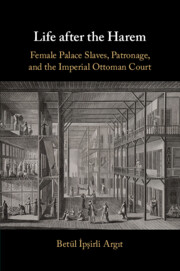Book contents
- Life after the Harem
- Life after the Harem
- Copyright page
- Dedication
- Contents
- Illustrations
- Maps
- Graphs
- Tables
- Acknowledgments
- Note on Usage
- Abbreviations
- Introduction
- 1 The Imperial Harem and Its Residents
- 2 Departure from the Imperial Palace and Changing Relationships with the Imperial Court
- 3 Marriage Patterns
- 4 Residential Districts and Relations with Society
- 5 Material World: Fortunes and Possessions
- 6 Charitable Activities: Architectural Patronage and Endowments
- Conclusion
- Appendix Residential Neighborhoods of Palace Women in intra muros Istanbul
- Bibliography
- Index
Introduction
Published online by Cambridge University Press: 08 October 2020
- Life after the Harem
- Life after the Harem
- Copyright page
- Dedication
- Contents
- Illustrations
- Maps
- Graphs
- Tables
- Acknowledgments
- Note on Usage
- Abbreviations
- Introduction
- 1 The Imperial Harem and Its Residents
- 2 Departure from the Imperial Palace and Changing Relationships with the Imperial Court
- 3 Marriage Patterns
- 4 Residential Districts and Relations with Society
- 5 Material World: Fortunes and Possessions
- 6 Charitable Activities: Architectural Patronage and Endowments
- Conclusion
- Appendix Residential Neighborhoods of Palace Women in intra muros Istanbul
- Bibliography
- Index
Summary
In 1799, a woman who signed her name as el-Hâcce Sarayî Fatma received a letter from the scribe of the Chief Black Eunuch. The letter informed her that due to the war against the infidels, her annual share of the mukataa (a fiscal unit administered as tax farm) would be reduced. el-Hâcce Sarayî Fatma Usta, who was previously the çaşnigir usta (mistress of the table service) in the imperial harem before moving to Medina, noted in the signed return letter that as female palace companions (saraylı yoldaş) living in Medina, she and other former harem residents had no other source of revenue apart from this share. This situation she considered to be a great injustice, especially since the women were living in the holy land. Fatma stated that the sultan was these women’s sole source of support and that the money not given to them would not benefit anyone else. Fatma then demanded that the women’s share be sent as usual. She noted that the women prayed to Allah that the Ottoman Empire should not need money assigned to the people of Medina. She also added that this share was not a protection (himaye); rather, the women had earned this share over their many years of serving several sultans (so long, in fact, that their hair had whitened). Because the women had also sold their jewelry and had saved through their hard work, this revenue could not be regarded “as apprenticeship or a freedom due, nor a gift” (çıraklık değil, ihsan değil). She finished her letter stating that the women wanted to spend the last days of their lives near Prophet Muhammed, and that they expected the state to show its generosity by helping them.2
- Type
- Chapter
- Information
- Life after the HaremFemale Palace Slaves, Patronage and the Imperial Ottoman Court, pp. 1 - 37Publisher: Cambridge University PressPrint publication year: 2020



